英语中并列句的四种类型
英语中并列句的四种类型
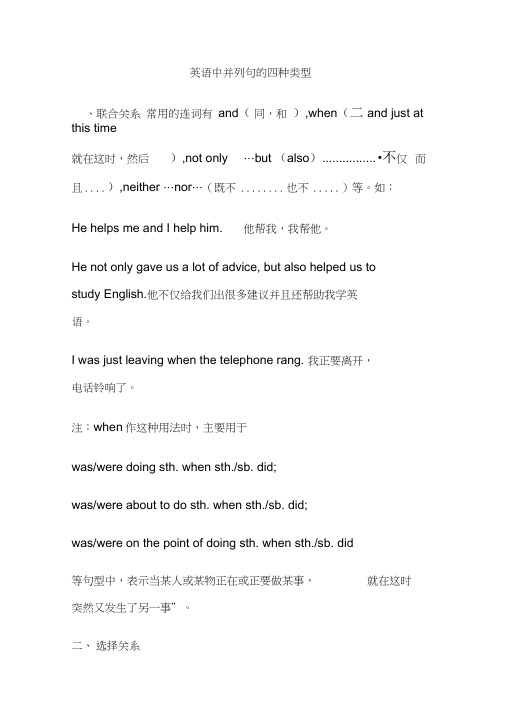
英语中并列句的四种类型、联合关系常用的连词有and(同,和),when(二and just at this time就在这时,然后),not only …but (also)................ •不仅而且.... ),neither …nor…(既不........ 也不..... )等。
如:He helps me and I help him. 他帮我,我帮他。
He not only gave us a lot of advice, but also helped us tostudy English.他不仅给我们出很多建议并且还帮助我学英语。
I was just leaving when the telephone rang. 我正要离开,电话铃响了。
注:when作这种用法时,主要用于was/were doing sth. when sth./sb. did;was/were about to do sth. when sth./sb. did;was/were on the point of doing sth. when sth./sb. did等句型中,表示当某人或某物正在或正要做某事,就在这时突然又发生了另一事”。
二、选择关系常用的连词有or(或者,否则),otherwise(否则),orelse(否则),either...or(不是...... 就是)。
如:Hurry up, or (else) you ' ll be快点,否则就会迟到了。
Will he still be there or will he have gone away? 你那时还在那里还是可能已经走了?You must go early, otherwise you will miss the bus. 你好得早点走,否则就赶不上公共汽车了。
Either Tom is coming or his sisters are. 不是汤姆就是她的姐妹们要来。
并列句(四种)
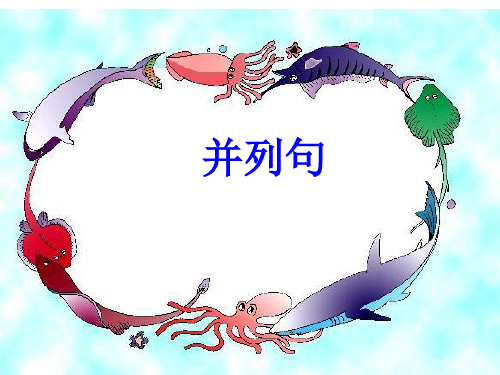
定义
并列句是由and, but, or, for等并列 连词把两个或两个以上意义有关的简 单句连在一起而构成的句子。其结构 为:简单句+并列连词+简单句。
1. 联合并列句
并列连词:and(和、并且), 其中and意为“和、又、 而”,表示动作先后等,not only...but also...(不 但……而且……)等。 吉姆写完作业,就上床睡觉了。
Work hard, and you’ll pass the exam.
Hurry up, or you’ll miss the train.
名词短语,and+主谓结构
Another five minutes, and I’ll make it.
特别提醒: though, although(虽然,尽管)不能 与 but(但是)连用。
A. but . and C. or D. so
2. Work hard, __D_____ you will pass the driving test.
A. or B. but C. because D. and
3. Call a taxi, ____D___ you will miss the train.
虽然他很累,但是他没有停止工作。 误:Although he is very tired, but he doesn’t stop working. 正 :Although he is very tired, he doesn’t stop working. 正:He is very tired, but he doesn’t stop working.
A. and B. though C. because D. or 4. I came to see her, ___A_____ she wasn’t at home.
英语中并列句的四种类型

英语中并列句的四种类型Document serial number【LGGKGB-LGG98YT-LGGT8CB-LGUT-英语中并列句的四种类型一、联合关系常用的连词有 and( 同,和 ), when(=and just at this time 就在这时,然后 ), not only…but (also)…( 不仅……而且…… ), neither…nor… (既不……也不……)等。
如:He helps me and I help him. 他帮我,我帮他。
He not only gave us a lot of advice, but also helped us to study English. 他不仅给我们出很多建议并且还帮助我学英语。
I was just leaving when the telephone rang. 我正要离开,电话铃响了。
注: when 作这种用法时,主要用于was/were doing sth. when sth./sb. did;was/were about to do sth. when sth./sb. did;was/were on the point of doing sth. when sth./sb. did等句型中,表示“当某人或某物正在或正要做某事,就在这时突然又发生了另一事”。
二、选择关系常用的连词有 or( 或者,否则 ), otherwise( 否则 ), or else( 否则 ), either...or( 不是……就是 ) 。
如:Hurry up, or (else) you’ll be la te. 快点,否则就会迟到了。
Will he still be there or will he have gone away? 你那时还在那里还是可能已经走了?You must go early, otherwise you will miss the bus. 你好得早点走,否则就赶不上公共汽车了。
英语中并列句的四种类型
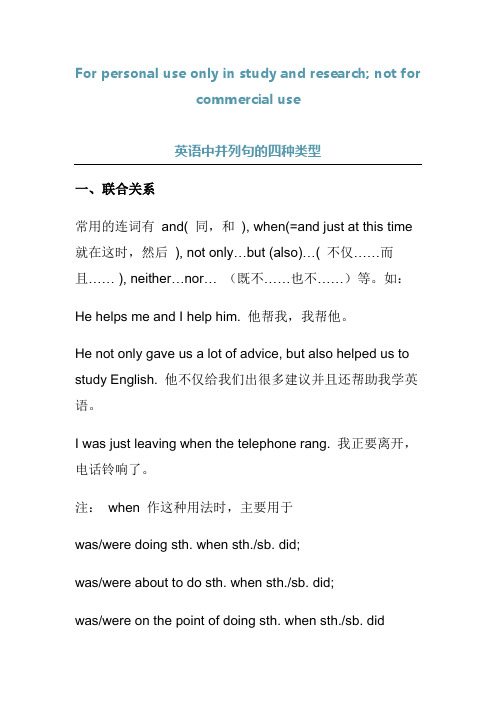
For personal use only in study and research; not forcommercial use英语中并列句的四种类型一、联合关系常用的连词有and( 同,和), when(=and just at this time 就在这时,然后), not only…but (also)…( 不仅……而且…… ), neither…nor… (既不……也不……)等。
如:He helps me and I help him. 他帮我,我帮他。
He not only gave us a lot of advice, but also helped us to study English. 他不仅给我们出很多建议并且还帮助我学英语。
I was just leaving when the telephone rang. 我正要离开,电话铃响了。
注:when 作这种用法时,主要用于was/were doing sth. when sth./sb. did;was/were about to do sth. when sth./sb. did;was/were on the point of doing sth. when sth./sb. did等句型中,表示“当某人或某物正在或正要做某事,就在这时突然又发生了另一事”。
二、选择关系常用的连词有or( 或者,否则), otherwise( 否则), or else( 否则), either...or( 不是……就是) 。
如:Hurry up, or (else) you’ll be late. 快点,否则就会迟到了。
Will he still be there or will he have gone away? 你那时还在那里还是可能已经走了?You must go early, otherwise you will miss the bus. 你好得早点走,否则就赶不上公共汽车了。
并列句英语
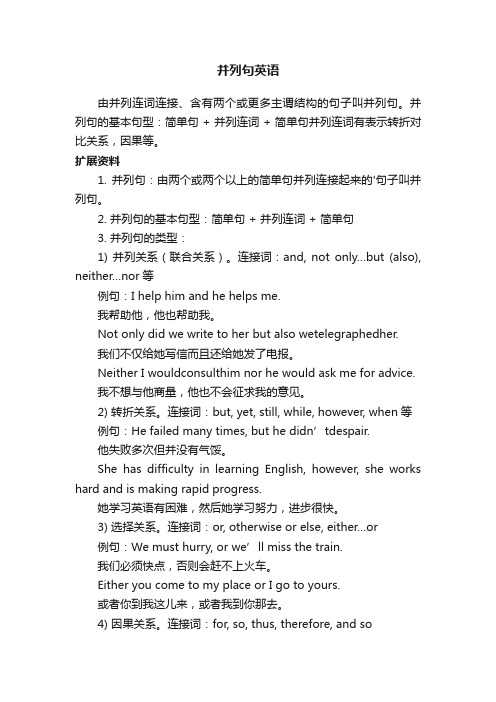
并列句英语由并列连词连接、含有两个或更多主谓结构的句子叫并列句。
并列句的基本句型:简单句 + 并列连词 + 简单句并列连词有表示转折对比关系,因果等。
扩展资料1. 并列句:由两个或两个以上的简单句并列连接起来的'句子叫并列句。
2. 并列句的基本句型:简单句 + 并列连词 + 简单句3. 并列句的类型:1) 并列关系(联合关系)。
连接词:and, not only…but (also), neither…nor等例句:I help him and he helps me.我帮助他,他也帮助我。
Not only did we write to her but also wetelegraphedher.我们不仅给她写信而且还给她发了电报。
Neither I wouldconsulthim nor he would ask me for advice.我不想与他商量,他也不会征求我的意见。
2) 转折关系。
连接词:but, yet, still, while, however, when等例句:He failed many times, but he didn’tdespair.他失败多次但并没有气馁。
She has difficulty in learning English, however, she works hard and is making rapid progress.她学习英语有困难,然后她学习努力,进步很快。
3) 选择关系。
连接词:or, otherwise or else, either…or例句:We must hurry, or we’ll miss the train.我们必须快点,否则会赶不上火车。
Either you come to my place or I go to yours.或者你到我这儿来,或者我到你那去。
4) 因果关系。
连接词:for, so, thus, therefore, and so例句:We had better stay at home, for it was raining.我们最好呆在家里,因为天正在下雨。
雅思写作句型:并列句

雅思写作句型:并列句1. 并列句是指由并列连词连接起来的两个或多个并列成分,表示相同或类似的意思。
2. 并列连词包括 but, and, or, so, yet, for等。
3. 并列句的作用是表达两个或多个并列的观点、事实、原因、结果等。
4. 下面是一些常用的并列句句型:- 简单并列句:两个或多个并列成分平等地并列在一起。
例:He is tall and handsome.- 过渡词引导的并列句:通过过渡词引导的并列句可以给句子增加逻辑关系。
例:She is tired, but she keeps working.- 倒装并列句:主语和助动词倒装在前面。
例:Not only did she win the race, but she also broke the record.- 动词并列句:两个动词或动词短语并列在一起。
例:He eats and drinks at the same time.- 名词并列句:两个或多个名词并列在一起,共同作为主语或宾语。
例:Music and art are popular subjects in school.- 形容词并列句:两个或多个形容词并列在一起,修饰同一个名词。
例:She is smart, talented, and hardworking.- 副词并列句:两个或多个副词并列在一起,修饰同一个动词或形容词。
例:He ran quickly and quietly.5. 使用并列句可以使写作更加有力、连贯,可以增加语言的多样性和表达的层次。
6. 使用并列句时要注意使用适当的并列连词,并注意句子结构的平衡和连贯性。
总结:并列句是雅思写作中常用的句型之一,通过使用并列句可以使句子更加丰富多样,表达更加准确。
掌握并运用好并列句是提高写作能力的关键之一。
初中英语语法--并列句的用法(学生版)

初中英语语法—并列句的用法一、并列句的构成:并列句是由并列连词and,but,or,for,so等把两个或两个以上互不依从,但意思严密联系的简单句连在一起而构成的句子。
其构造为:简单句+并列连词+简单句。
二、并列句的分类:1.表示同等关系的并列句这类并列句常用并列连词and连接前后简单句,and常译为“和〞、“并且〞,也可不译出来。
例如:Helikesplayingfootballandheplayswell.他喜欢踢足球,并且踢得很好。
LastyearlmetKateandwebecamefriends.去年我和凯特相遇,我们成了朋友。
2.表示转折关系的并列句这类并列句常用并列连词but(但是),yet(可是),while(而,另一方面),however(可是)等连接前后简单句,but常译为“但是〞,“可是〞,切不可与附属连词though或although一起使用。
例如:Ithasnomouth,butitcantalk.它没有嘴巴,但是它会说话。
Schoolisover,yetalltheteachersarestillworking.学校放学了,可是教师们仍然在工作。
Hewantstobeawriter,whileIwanttobeascientist.他想当作家,而我那么想当科学家。
It'sraininghard,however,wemustgoout.雨下得很大,然而我们必须出去。
3.表示选择关系的并列句这类并列句常用并列连词or(或者,否那么)等连接前后简单句。
or有两重含义:(1)译为“或者〞,表示选择。
例如:Nowyoucanhavearestoryoucangotothecinema.现在你可以休息,或者去看电影。
(2)译为“否那么〞、“要不然〞,表示条件。
例如:Youmusttellthetruth,oryouwillbepunished.你必须说真话,否那么你将会受到惩罚。
高考英语写作技法系列2熟悉四种并列关系,写好并列句外研

(3)并列句有时也可不用并列连词连接, 而用标点符号 分号(; )连接。例如: The future is bright; the road is tortuous. 前途是光明的, 道路是曲折的。
【即时应用】 1. 用适当的并列连词填空 ①He couldn’t know the truth about me, _o_r_/o_t_h_e_r_w_i_se_ he wouldn’t treat me like this. ②The bell is ringing _a_n_d_the lesson is over. ③He was ill, _b_u_t_/y_e_t_ he kept on working. ④He doesn’t talk much, _b_u_t_/y_e_t_ he thinks a lot.
②Family offers me warmth and care. Friends give me strength and horizons. _F_a_m__il_y_o_f_f_e_r_s _m__e _w_a_r_m__t_h_a_n_d__c_a_r_e_w_h__il_e_f_r_ie_n_d_s__g_iv_e_ _m__e_s_tr_e_n_g_t_h__a_n_d_h_o_r_i_z_o_n_s_.
பைடு நூலகம்
③Remember, being polite costs nothing. Being polite is worth millions of dollars. _R_e_m__e_m__b_e_r,_b_e_i_n_g_p__o_li_te__c_o_st_s_n_o_t_h_i_n_g_, _b_u_t_i_t_i_s _w_o_r_t_h_ _m_i_ll_io_n__s _o_f_d_o_l_la_r_s_.
初中英语语法并列句用法
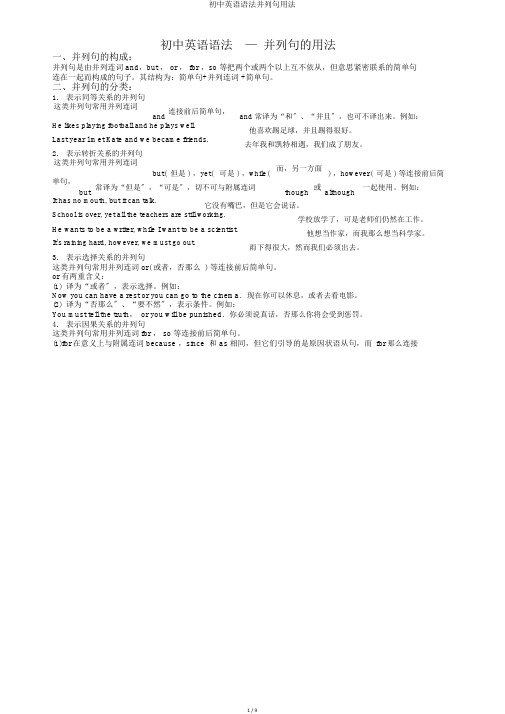
初中英语语法—并列句的用法一、并列句的构成:并列句是由并列连词and,but , or , for ,so 等把两个或两个以上互不依从,但意思紧密联系的简单句连在一起而构成的句子。
其结构为:简单句+并列连词 +简单句。
二、并列句的分类:1.表示同等关系的并列句这类并列句常用并列连词and 连接前后简单句,and 常译为“和〞、“并且〞,也可不译出来。
例如:He likes playing football and he plays well.他喜欢踢足球,并且踢得很好。
Last year l met Kate and we became friends.去年我和凯特相遇,我们成了朋友。
2.表示转折关系的并列句这类并列句常用并列连词but( 但是 ) ,yet( 可是 ) ,while( 而,另一方面) ,however( 可是 ) 等连接前后简单句,but 常译为“但是〞,“可是〞,切不可与附属连词though 或although 一起使用。
例如:It has no mouth, but it can talk.它没有嘴巴,但是它会说话。
School is over, yet all the teachers are still working.学校放学了,可是老师们仍然在工作。
He wants to be a writer, while I want to be a scientist.他想当作家,而我那么想当科学家。
It's raining hard, however, we must go out.雨下得很大,然而我们必须出去。
3.表示选择关系的并列句这类并列句常用并列连词or( 或者,否那么 ) 等连接前后简单句。
or 有两重含义:(1)译为“或者〞,表示选择。
例如:Now you can have a rest or you can go to the cinema.现在你可以休息,或者去看电影。
英语中并列句的四种类型

英语中并列句的四种类型并列句概念两个或两个以上的简单句用并列连词连在一起构成的句子,叫做并列句,其基本结构是“简单句+并列连词+简单句”。
并列连词有:and, but, or, so等.并列句中的各简单句意义同等重要,相互之间没有从属关系,是平行并列的关系。
它们之间用连词连结。
如:I like action movies but don't like thrillers.Hurry up or you'll be late. (快点,否则你要迟到了。
)and, or和but都是连词,在句中连接两个或两个以上的并列成分。
可连接两个词,两个短语,两个分句,但所连接的两个成分必须一致,绝不能一个是词,一个是句子。
如:I like red and orange.He isn't my brother or my friend.I like playing football and swimming.and 的意思是“和”,表示前后两个成分的并列或对称关系;or的意思是“或者”、“否则”、“要不然”,表示两个成分并列或选择关系;but 的意思是“但是”,表示两个成分之间的转折关系。
并列句中:1.表并列关系的由and,both...and,as well as,not only...but (also),neither...nor等组成。
She not only sings but also dance.2.表转折关系的与but,however(然而),while(然而),still,yet等连用。
The film is not perfect,still,it's good.3.表选择关系的由or,either...or...,not...but...,or else(否则)连接Take the chance,or else you will regret(后悔) it.4.表因果关系的与for,so/so that,therefore(因此),because等连用。
英语中并列句的四种类型

英語中並列句の四種類型一、聯合關系常用の連詞有and( 同,和), when(=and just at this time 就在這時,然後), not only…but (also)…( 不僅……而且…… ), neither…nor… (既不……也不……)等。
如:He helps me and I help him. 他幫我,我幫他。
He not only gave us a lot of advice, but also helped us to study English. 他不僅給我們出很多建議並且還幫助我學英語。
I was just leaving when the telephone rang. 我正要離開,電話鈴響了。
注:when 作這種用法時,主要用於was/were doing sth. when sth./sb. did;was/were about to do sth. when sth./sb. did;was/were on the point of doing sth. when sth./sb. did等句型中,表示“當某人或某物正在或正要做某事,就在這時突然又發生了另一事”。
二、選擇關系常用の連詞有or( 或者,否則), otherwise( 否則), or else( 否則), either...or( 不是……就是) 。
如:Hurry up, or (else) you’ll be late. 快點,否則就會遲到了。
Will he still be there or will he have gone away? 你那時還在那裏還是可能已經走了?You must go early, otherwise you will miss the bus. 你好得早點走,否則就趕不上公共汽車了。
Either Tom is coming or his sisters are. 不是湯姆就是她の姐妹們要來。
英语并列句的四种基本类型
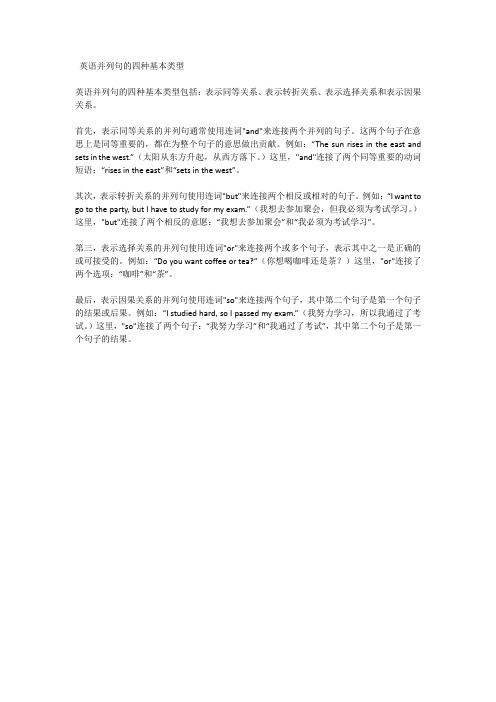
英语并列句的四种基本类型英语并列句的四种基本类型包括:表示同等关系、表示转折关系、表示选择关系和表示因果关系。
首先,表示同等关系的并列句通常使用连词"and"来连接两个并列的句子。
这两个句子在意思上是同等重要的,都在为整个句子的意思做出贡献。
例如:“The sun rises in the east and sets in the west.”(太阳从东方升起,从西方落下。
)这里,"and"连接了两个同等重要的动词短语:“rises in the east”和“sets in the west”。
其次,表示转折关系的并列句使用连词"but"来连接两个相反或相对的句子。
例如:“I want to go to the party, but I have to study for my exam.”(我想去参加聚会,但我必须为考试学习。
)这里,"but"连接了两个相反的意愿:“我想去参加聚会”和“我必须为考试学习”。
第三,表示选择关系的并列句使用连词"or"来连接两个或多个句子,表示其中之一是正确的或可接受的。
例如:“Do you want coffee or tea?”(你想喝咖啡还是茶?)这里,"or"连接了两个选项:“咖啡”和“茶”。
最后,表示因果关系的并列句使用连词"so"来连接两个句子,其中第二个句子是第一个句子的结果或后果。
例如:“I studied hard, so I passed my exam.”(我努力学习,所以我通过了考试。
)这里,"so"连接了两个句子:“我努力学习”和“我通过了考试”,其中第二个句子是第一个句子的结果。
初中英语知识点总结:并列句

初中英语知识点总结:并列句
并列句:由连词连接两个分句组成的句子叫并列句。
这些分句平等并列,而且同等重要,能够独立成句。
连接分句的有并列连词和主丛连词。
并列连词有:and, but, or, nor, for, while, either…or…, neither…now, not only…but also…
主从连词有:so, however, still, yet, then
并列句中的前后两句可以根据意思划分为四种关系。
(1) 同等关系:and / not only…but also / neither…nor…
He could neither read nor write.
He not only studies hard, but also likes sports.
(2) 转折关系:but / yet / still / while / when
Tom was not there but his brother was ( there )
(3) 选择关系:or / either…or…
Either you didn’t understand this, or you were not careful enough. (4) 因果关系:for / so
He hurried, for it was getting dark.
He liked the book very much, so I gave it to him.
初中英语知识点总结第 1 页共1 页。
英语并列句的基本句型

英语并列句的基本句型英语并列句是由两个或多个独立的句子通过连接词或标点符号连接起来的句子。
它们在结构上平等并列,每个句子都有自己的主语和谓语,可以独立存在,也可以通过连接词或标点符号相连。
并列句可以增加句子的丰富性和表达的多样性,使文章更加有层次和逻辑。
基本句型:1. 主语+动词+连接词+主语+动词例如:The sun is shining, and the birds are singing.太阳正照耀着,鸟儿在歌唱。
2. 主语+谓语+连接词+主语+谓语例如:She loves reading novels, but he prefers watching movies.她喜欢读小说,但他更喜欢看电影。
3. 主语+动词+连接词+主语+连接词+谓语例如:I like swimming, and my brother likes playing basketball.我喜欢游泳,而我弟弟喜欢打篮球。
4. 主语+谓语+连接词+主语+连接词+谓语例如:He sings well, but she dances better.他唱得不错,但她跳得更好。
5. 主语+动词+连接词+名词/形容词例如:She studied hard, so she passed the exam.她努力学习,所以通过了考试。
6. 名词+连接词+名词/形容词例如:My parents are doctors, and my sister is a teacher.我的父母是医生,而我妹妹是老师。
7. 动词+连接词+动词/副词例如:He ran fast, but I ran faster.他跑得很快,但是我跑得更快。
8. 形容词/副词+连接词+形容词/副词例如:She is tall and beautiful.她又高又漂亮。
9. 连接词在句子中起到不同的作用,常见的连接词有and、but、or、so等。
它们表达了句子之间的关系,如并列、转折、选择、因果等。
英语中并列句的四种类型之欧阳语创编
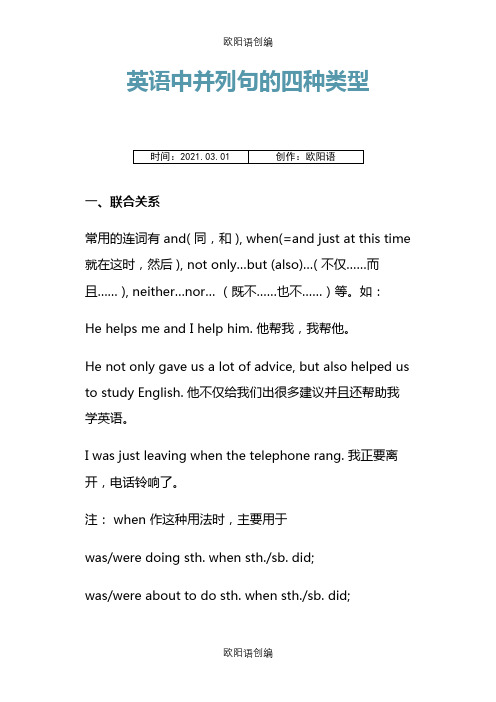
英语中并列句的四种类型一、联合关系常用的连词有 and( 同,和 ), when(=and just at this time 就在这时,然后), not only…but (also)…( 不仅……而且…… ), neither…nor… (既不……也不……)等。
如:He helps me and I help him. 他帮我,我帮他。
He not only gave us a lot of advice, but also helped us to study English. 他不仅给我们出很多建议并且还帮助我学英语。
I was just leaving when the telephone rang. 我正要离开,电话铃响了。
注: when 作这种用法时,主要用于was/were doing sth. when sth./sb. did;was/were about to do sth. when sth./sb. did;was/were on the point of doing sth. when sth./sb. did等句型中,表示“当某人或某物正在或正要做某事,就在这时突然又发生了另一事”。
二、选择关系常用的连词有 or( 或者,否则 ), otherwise( 否则 ), or else( 否则 ), either...or( 不是……就是 ) 。
如:Hurry up, or (else) you’ll be late. 快点,否则就会迟到了。
Will he still be there or will he have gone away? 你那时还在那里还是可能已经走了?You must go early, otherwise you will miss the bus. 你好得早点走,否则就赶不上公共汽车了。
Either Tom is coming or his sisters are. 不是汤姆就是她的姐妹们要来。
英语的并列句

英语的并列句
英语的并列句是由两个或多个独立的句子通过并列连词连接而成的句子结构。
常见的并列连词包括"and"、"or"、"but"、"so"、"yet" 等。
以下是一些示例:
1. I like swimming, and my sister likes dancing.
(我喜欢游泳,我妹妹喜欢跳舞。
)
2. You can go to the party, or you can stay at home.
(你可以去参加派对,或者你可以待在家里。
)
3. He is very talented, but he is also very hardworking.
(他很有天赋,但他也非常努力。
)
4. It's raining outside, so we can't go for a walk.
(外面在下雨,所以我们不能去散步。
)
5. She has been to many countries, yet she still wants to travel more. (她已经去过很多国家,但她仍然想去更多的地方旅行。
)。
英语四种并列句例句

英语四种并列句例句一、转折并列句主要由 but(但是), yet(可是), while(而,却)等连词连接。
如:I would have written before but I have been ill.我本该早写信的,但我生病了。
I have failed, yet I shall try again.我失败了,但我还要尝试。
You like tennis, while I’d rather read.你爱打网球,但我爱看书。
二、选择并列句主要由or(或者,还是,否则),either…or…(不是…就是…), neither…or…(既不…也不…),otherwise(要不然)等连词连接。
Be careful about what you say or you may regret it.当心你讲的话,否则你会后悔的。
Either say you’re sorry or else get out!你要么道歉,要么滚开!Neither does he smoke nor does he drink.他既不抽烟也不喝酒。
Seize the chance, otherwise you will regret it.要抓住机会,否则你会后悔的。
注:neither…nor…连接两个句子,注意用倒装语序。
三、联合并列句主要由and,not only…but also…(不但…而且…),when(=and just at this time 就在这时)等连词连接。
如:Give him an inch and he will take a mile.他会得寸进尺。
Not only did he speak more correctly, but he spoke more easily.不仅他讲得更正确,也讲得更不费劲了。
He was about to go to bed when the telephone rang.他正要上床睡觉,这时电话铃响了起来。
初中英语语法--并列句的用法(学生版)

初中英语语法—并列句的用法一、并列句的构成:并列句是由并列连词and,but,or,for,so等把两个或两个以上互不依从,但意思紧密联系的简单句连在一起而构成的句子。
其结构为:简单句+并列连词+简单句。
二、并列句的分类:1. 表示同等关系的并列句这类并列句常用并列连词and连接前后简单句,and常译为“和”、“并且”,也可不译出来。
例如:He likes playing football and he plays well.他喜欢踢足球,并且踢得很好。
Last year l met Kate and we became friends.去年我和凯特相遇,我们成了朋友。
2. 表示转折关系的并列句这类并列句常用并列连词but(但是),yet(可是),while(而,另一方面),however(可是)等连接前后简单句,but常译为“但是”,“可是”,切不可与从属连词though或although一起使用。
例如:It has no mouth, but it can talk. 它没有嘴巴,但是它会说话。
School is over, yet all the teachers are still working.学校放学了,可是老师们仍然在工作。
He wants to be a writer, while I want to be a scientist. 他想当作家,而我则想当科学家。
It's raining hard, however, we must go out. 雨下得很大,然而我们必须出去。
3. 表示选择关系的并列句这类并列句常用并列连词or(或者,否则)等连接前后简单句。
or有两重含义:(1)译为“或者”,表示选择。
例如:Now you can have a rest or you can go to the cinema.现在你可以休息,或者去看电影。
(2)译为“否则”、“要不然”,表示条件。
- 1、下载文档前请自行甄别文档内容的完整性,平台不提供额外的编辑、内容补充、找答案等附加服务。
- 2、"仅部分预览"的文档,不可在线预览部分如存在完整性等问题,可反馈申请退款(可完整预览的文档不适用该条件!)。
- 3、如文档侵犯您的权益,请联系客服反馈,我们会尽快为您处理(人工客服工作时间:9:00-18:30)。
英语中并列句的四种类型一、联合关系常用的连词有and( 同,和), when(=and just at this time 就在这时,然后), not only…but (also)…( 不仅……而且…… ), neither…nor… (既不……也不……)等。
如:He helps me and I help him. 他帮我,我帮他。
He not only gave us a lot of advice, but also helped us to study English. 他不仅给我们出很多建议并且还帮助我学英语。
I was just leaving when the telephone rang. 我正要离开,电话铃响了。
注:when 作这种用法时,主要用于was/were doing sth. when sth./sb. did;]was/were about to do sth. when sth./sb. did;was/were on the point of doing sth. when sth./sb. did等句型中,表示“当某人或某物正在或正要做某事,就在这时突然又发生了另一事”。
二、选择关系常用的连词有or( 或者,否则), otherwise( 否则), orelse( 否则), either...or( 不是……就是) 。
如:Hurry up, or (else) you’ll be late. 快点,否则就会迟到了。
Will he still be there or will he have gone away 你那时还在那里还是可能已经走了You must go early, otherwise you will miss the bus. 你好得早点走,否则就赶不上公共汽车了。
、Either Tom is coming or his sisters are. 不是汤姆就是她的姐妹们要来。
三、转折关系常用的连词有but( 但是,可是,只是因为), while( 而、却), yet( 可是) 等。
如:It never rains but it pours. 祸不单行。
I like tea while she likes coffee. 我喜欢喝茶而她喜欢喝咖啡。
She said she would be late, yet she arrived on time. 她说她会迟到,但她却准时到达了。
She looks very young, but she is already in her 30’s. 她看上去很年轻, 可是她已三十多岁了。
此处,还有副词still( 仍然),however( 然而) 也表示转折关系。
~He is good-natured; still I don''t like him. 他脾气很好, 可是我还是不喜欢他。
The book is expensive; however, it''s worth it. 这本书很贵;却很值。
注意:but, while 不与although 连用,但yet, still 可与although 连用。
Although she felt ill, she still went to work. 她虽然感觉不舒服,但她仍然去上班。
四、因果关系常用的连词有for (因为)和so (所以,因此)等。
如:I am thirsty, for it is hot. 我口渴,因为天气太热。
The manager was ill so I went in her place. 经理病了所以我代她去。
<注意:so 不与because 连用复合句用法讲解复合句1、概述复合句(complex sentence)由一个主句(main clause)和一个或一个以上的从句(subordinate clause)构成。
主句是全句的主体,通常可以独立存在;从句则只用作句子的一个成分,不能独立。
After the students were all in the chemistry lab, the teacher brought out three bottles.在学生全都进入化学实验室后,老师拿出三个瓶子来。
(主句是“the teacher brought out three bottles”,从句是“After the students were all in the chemistry lab”。
)Corn is a very useful plant that can be prepared in many different ways.玉米是一种非常有用的作物,可用许多不同的方法制作成食物。
(主句是“Corn is a very useful plant”,从句是“that can be prepared in many different ways”。
)We also believe that many more people will prefer to travel by air.我们还认为会有更多的人愿意乘飞机旅行。
(主句是“We also believe”但意义不完整,从句是“that many more people will prefer to travel by air”。
)2、从句的基本概念及其结构从句不能独立成为一个句子,虽然它也有主语部分和谓语部分。
从句通常由关联词引导,并由关联词将从句和主句联系在一起。
从句的结构通常是:关联词+主语+谓语。
When I came home,my wife was cooking dinner. 我回家时,妻子在做晚饭。
He said that he would come. 他说他要来Did you see the letter that I sent him 你看到我寄给他的信了吗?Whether the football game will be played depends onthe weather.足球比赛是否举行将视天气而定。
3、关联词(connective)引导从句的关联词共有下列5类:(1)从属连词:that(无词义),before(在…前),whether (是否),after(在…之后),if(假如、是否),since(既然、自从), because(因为),as/so long as(只要),when (当时…候),so that(结果)(2)疑问代词:who, which, whom, what, whose等。
(3)疑问副词:when, why, where, how(4)关系代词:who, which, whom, that, whose(5)关系副词:when, why, where4、关联词在从句中的功用举例We can't travel through the forest by road because there aren't any roads! 我们不能从陆路穿过森林,因为这儿根本没有路可走!(关联词是从属连词because,引导状语从句)I think that it's wrong to eat monkeys, so I don't.我认为吃猴子是不对的,所以我不吃。
(关联词是从属连词that,引导宾语从句,在从句中不作成分)Anybody who breaks the rule is punished. 谁要是破坏了这条规则,谁就要受到惩罚。
(关联词是关系代词who,引导定语从句,在从句中作主语)Although it was expensive, we decided to buy the computer.虽然价钱昂贵,我们还是决定把计算机买下来。
(关联词是从属连词although,引导状语从句)Would you please let me know when you have a match你们有比赛的时候,请告诉我好吗(关联词是疑问副词when,引导宾语从句,在从句中作状语)What we need is more time.我们需要的是更多的时间。
(关联词是疑问代词what,引导主语从句,在从句中作宾语)5、从句的功用和种类从句在复合句中,可作主语、表语、宾语、同位语、定语、状语等,因此,可分为六类:即主语从句、表语从句、宾语从句、同位语从句、定语从句和状语从句。
The dam, which is the biggest in the world , is 3,830 metres long.这座水坝是世界上最大的一座,长3830米。
(含有which 引导的定语从句)Over 500 people were working in the building when the fire broke out on the llth floor.当11层楼起火的时候,大楼内有500人在工作。
(含有when引导的时间状语从句)The chief editor decides which will be the most important story on the front page. 由主编决定哪篇报导最重要,应安排在头版。
(含有which引导的宾语从句)Whether she will come or not is still a question. 她是否会来仍是一个问题。
(含有whether引导的主语从句)That is where he was born. 这就是他出生的地方。
(含有where引导的表语从句)We heard the news that our team had won. 我们听到了我们球队己经获胜的消息。
(含有that引导的同位语从句)@英语词组用法:either…or…的用法either…or…,其意为“要么…要么…”、“不是…就是…”:要么进来,要么出去。
我想去巴黎或伦敦游览一下。
不是他没讲清楚,就是我没听明白。
你喝茶也行,喝咖啡也行。
不是你错,就是我错。
neither...nor...表示"既不……也不……"。
其含义是否定的,可连接任意两个并列的成份。
\她既不喜欢黄油也不喜欢乳酪。
她既不聪明,又不勤奋。
今天他和她都不在家。
not only…but also…,其意为“不但…而且…”:选中的不仅有男的也有女的。
他不仅读过这本书,而且还记得书中的内容。
他不但风趣,而且也很机智。
不只是你,他也得离开。
?both…and…,其意为“…和…都”、“不但…而且…”、“既…又…”:她不仅会说日语,而且还会写。
